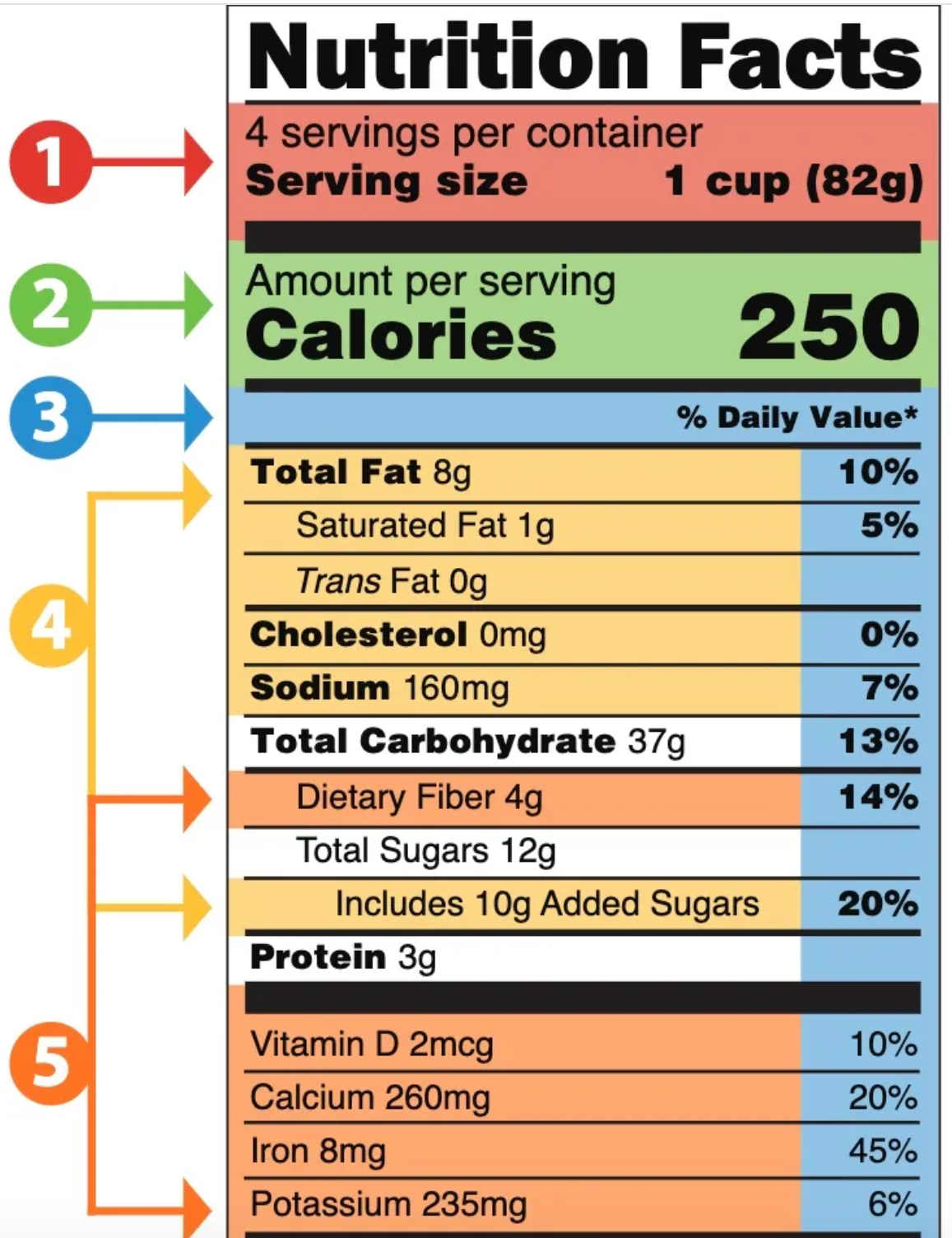UNDERSTANDING NUTRITION LABELS A COMPREHENSIVE GUIDE

Nutrition labels are essential for making informed dietary choices but can often seem overwhelming or confusing. This guide aims to break down the components of a nutrition label so you can make healthier, more confident decisions.

1. Serving Size
The serving size is the first information on a nutrition label and is crucial for understanding the rest of the data. It tells you the quantity of food based on which the nutritional information is based.
In this food label sample - it has 4 servings per container. This is why we recommend you always check the serving size because it may differ from what you consume. If a serving size is 1 cup and you eat 2 cups, you must double all the nutritional values.
2. Evaluate Calories
Calories indicate the energy you get from a serving of the food. Balancing the calories you consume with the calories you burn through physical activity is critical to managing your weight.
Remember, if the serving size is small and you eat more than one serving, you must multiply the calories by the number of servings you eat. In this sample 1 serving is 250 calories if you eat 2 servings 250X2=500 calories.
Remember that if you are trying to lose weight, you have to burn more calories than you consume, so losing weight means eating a little less and staying active way more!
3. Percent Daily Value (%DV)
The %DV shows how much a nutrient in a serving of the food contributes to a daily diet, based on a 2,000-calorie-a-day diet, a general guideline. Here’s how to use %DV:
- 5% DV or less is considered low. Aim low for nutrients like saturated fat, trans fat, cholesterol, and sodium.
- 20% DV or more is considered high. Aim high for nutrients like dietary fiber, vitamin D, calcium, iron, and potassium. Additionally if you are looking for an item "high" in protein 20% is a good starting point.
4. Watch out for these
Overeating total fat (incredibly saturated fat and trans fat), cholesterol, sodium, or added sugars may increase your risk of developing chronic diseases.
Brickz Tip: Added sugars are sugars, and syrups added to our foods or beverages when processed or prepared. These sugars do not include naturally occurring sugars in milk and fruits. Additionally, a good rule of thumb is to limit added sugars to 10% of your daily calories.
5. Micronutrients
Micronutrients are vitamins and minerals that are crucial for overall health. Commonly listed micronutrients include:
Vitamin DCalcium
Iron
Potassium
These nutrients are essential for bone health, blood health, and overall cellular function. A higher %DV of these nutrients significantly contributes to your daily requirements.
Understanding your Macronutrients:
Carbs, Protein, and Fats
Understanding macronutrients is vital for maintaining a balanced diet:
Carbohydrates (Carbs)Total Carbohydrates include all carbs, such as sugar, complex carbs, and fiber.
Dietary Fiber is a type of carb that your body cannot digest. Fiber aids digestion and can help control blood sugar levels.
Sugars include natural (like those found in fruit) and added sugars. High added sugar intake is linked to various health issues, so be aware.
Protein
Protein is essential for building and repairing tissues and for immune function. Look at the grams of protein per serving to ensure you're meeting your dietary needs.
Fats
Total Fat includes all types of fats in the food.
Saturated Fat and trans fat are unhealthy fats that can increase one's risk of heart disease. Aim to consume these in limited amounts.
Unsaturated Fats (not always listed separately) are healthier fats commonly found in nuts, seeds, and fish.
Ingredients List
The ingredients list is also a vital part of the nutrition label. Ingredients are listed in descending order by weight, so the first few ingredients make up the bulk of the food.
Whole Foods: Foods that list whole grains or whole food ingredients first are typically healthier.
Added Sugars and Sodium: Many processed foods contain added sugars and sodium. Ingredients like high fructose corn syrup, cane sugar, or salt indicate added sugars and sodium.
Practical Tips for Using Nutrition Labels
- Compare Products: Use nutrition labels to compare similar products and choose the healthier option.
- Watch Serving Sizes: Always adjust the nutritional information based on how much food you eat.
- Focus on Whole Foods: Choose foods with fewer, more recognizable ingredients.
- Limit Added Sugars and Unhealthy Fats: Opt for products lower in added sugars and unhealthy fats.
- Use %DV Wisely: Aim for a high %DV of beneficial nutrients (like fiber and vitamins) and a low %DV of nutrients you should limit (like saturated fat and sodium).
By understanding how to read and interpret nutrition labels, you can make more informed choices that contribute to a healthier, more balanced diet.
Cheers to Happy & Healthy Eating!
